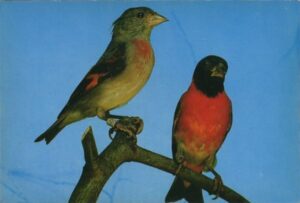The Red Siskin (Carduelis cucullata) is a bird native to South America and averages four inches (10cm) in length, and with striking vermilion plumage, especially on the males. On females, the brightest red coloring is on the upper breast, and a more faded red appears on their wing bar, rump and undertail-coverts. Males, however, are covered in vivid red almost throughout – on their breast, belly, undertail- and uppertail-coverts, rump, wing bars and back of the neck. Males also have a black hood that covers their head, from the neck up; gray feathers cover the head and upper back of females. Juveniles are born with all gray plumage and don’t begin to molt until around four months. At this point, they begin to take on some red color, which continues to deepen as the bird gets older.
To identify the bird by call, listen for a high-pitched chitter or sharp chi-tit. Males also have a beautiful song, similar to a goldfinch, with twitters and trills.

Habitat
In the early 20th century, the Red Siskin used to flourish in the foothills of northern Venezuela where it was commonly found in open country, along forest edges (both moist evergreen forest and dry deciduous woodlands) and in grassland areas with trees or shrubs. But because of their beautiful red color, wild populations of the Red Siskin have greatly decreased. For more than 150 years the birds endured hunting and capturing by breeders trying to create a red canary for the caged-bird industry.
For many years, the Red Siskin population was believed to be nearing extinction, so it came as a surprise in April 2000 when researchers from the University of Kansas and the Smithsonian Institution, along with the South Rupununi Conservation Society (SRCS), discovered a population of several thousand Red Siskins in southern Guyana, some 950km from the nearest known Venezuelan population. This was the first time the bird was discovered in Guyana, and the number found was much larger than the previously recorded wild population.
The South Rupununi Savannas – the habitat in Guyana where the birds are found – covers approximately 3,000 square miles of land. The expansive grasslands are dotted with tropical forest covered mountains, and it’s at interfaces between savanna and forested mountains areas where the populations are found. The SRCS has been studying two transect sites in the South Rupununi – one in the east and one in the west – that are separated by roughly 100 miles.
Behavior
The Red Siskin can typically be found in semi-nomadic flocks that move between 100–1,300 meters on a seasonal and daily basis. The Siskins have two breeding seasons, one around April and a lesser one around November. In Venezuela, nests were found in bromeliads in tall trees; in Guyana Red Siskins have been observed nesting in dense clumps of leaves at the top of Curatella trees. Nests in Guyana have been found with two or three eggs in them. The birds eat fruits of caimbe and sandpaper trees, flower buds, seeds and some herbaceous plants.
Conservation
As the Red Siskin is listed as endangered with CITES, the importance of immediately surrounding Guyana’s population with conservation efforts was obvious from the beginning, as was the decision to appoint a local body to oversee these efforts. The South Rupununi Conservation Society is headquartered at Dadanawa Ranch and is composed of members from nearby Amerindian villages and local communities. In an effort to protect the Siskin, the SRCS began seeking international funding for a conservation project surrounding the bird. Their efforts landed them a 12-month grant from the British Petroleum International Conservation Program.
The grant is being used to establish a population estimate, create a distribution map and collect baseline data of the bird’s behavior and habitat for academia, scientists, conservationists and birdwatchers from around the world. The grant also enables the group to carry out conservation-based educational activities in local communities to heighten awareness of the Red Siskin and hopefully lessen any human impact on its population.
To help with their monitoring efforts, the SRCS has been banding the birds in color codes to identify individuals and monitor their movement patterns between different areas. If the banding is successful, and more funding can be secured, the SRCS would also like to equip some birds with radio telemetry equipment that would allow for more precise monitoring. In the future, the SRCS hopes to work with Brazilian conservation groups to see if the population stretches into the neighboring country, where there are pockets of similar habitat.
The Red Siskin in protected in Guyana and it is illegal to trap it or to keep it as a caged bird. The SRCS remains actively engaged in protecting the bird under the endangered species act, and in doing so interacts with other conservation and scientific based organizations such as Conservation International, The Smithsonian Institute and Guyana’s Environmental Protection Agency.






